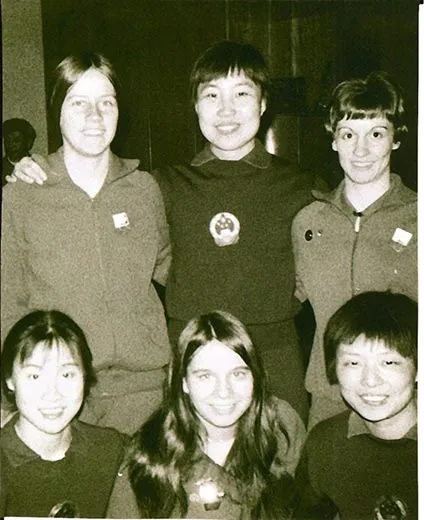Connie Sweeris, Ping-Pong Diplomat
A 1971 table tennis competition between the U.S. and China laid the groundwork for a foreign relations breakthrough
/https://tf-cmsv2-smithsonianmag-media.s3.amazonaws.com/filer/ping-pong-diplomacy-USA-China-teams-631.jpg)
In 1971, relations were chilly between Communist China and the United States. But the unassuming sport of table tennis helped bring these two countries just a little bit closer.
In April of that year, at the invitation of the Chinese government, a nine-person United States table tennis team, along with their spouses, team officials and a few selected journalists, visited China for a series of exhibition matches. So-called Ping-Pong diplomacy was born, helping to set the stage for President Richard Nixon’s visit in February 1972. “No one was envisioning that this dramatic trip to China would be a precursor to re-establishing diplomatic relations,” said Steve Bull, director of government relations for the U.S. Olympic Committee and a former Nixon aide, in an interview with the Honolulu Advertiser.
USA Table Tennis hall of famer Connie Sweeris, one of the members of the 1971 team, was the reigning U.S. national champion at the time of the China trip, having just completed in the Triple Crown of women’s singles, women’s doubles and mixed doubles championships. Table tennis runs strong in Sweeris’ family—she’s married to her doubles partner, Dell Sweeris, another hall of famer, and their son Todd is a former two-time table tennis Olympian.
The magazine’s Jeff Campagna corresponded with Connie Sweeris by e-mail about her historic trip to China.
Were you more scared or excited about the chance to visit China?
I was both scared and excited about the opportunity to visit China. I was scared because I knew very little about China and its people. Plus, no American had been allowed into China since 1949 when the Communist Party took over the government. Safety traveling in a Communist country was a concern for most all of the American team. But my apprehension soon gave way to the thought that the Chinese would do everything in their power to keep us safe. They would not want an international incident to happen since our trip was making headline news all over the world. I was also excited at the same time to see another foreign country and play table tennis with some of the greatest players in the world.
Were you and your teammates given certain instructions by the U.S. government before you went there?
The American team was not given any instructions by the U.S. government other than saying they recognized the political implications of the visit and that we would not engage in politics. They also recognized the public relations aspect of the trip. [Graham] Steenhoven, president of the United States Table Tennis Association [USTTA], gave us a few instructions. He said we were to show goodwill and sportsmanship. We were not to call the Chinese people Chinamen. He wanted us to act as responsible, well-mannered Americans representing the USTTA.
What were communications like between you and the Chinese table tennis players-how did you get along?
The way we communicated with the Chinese table tennis players was through interpreters and hand motions. It was a little difficult to talk often because there were 15 Americans and only a few interpreters. The Chinese players were very friendly and treated us with respect and kindness.
And just how good were they?
The Chinese table tennis players were very skilled. Their men’s and women’s teams were just getting back from the world competition in 1971 in Japan after the Cultural Revolution in China. They were considered to be some of the best table tennis players in the world.
What kind of reactions did you and your teammates get from the Chinese people during your sightseeing excursions?
The Chinese people looked at us with curiosity. A lot of the younger people of China probably had never seen any Americans. Glenn Cowan, one of our male table tennis players, wore his hair long. They sure were amazed with that!
At the time, did you have any idea of how important your trip would be to opening up future U.S.-China relations?
At the time we were in China, we knew our trip was pretty newsworthy because of all the reporters wanting our stories. However, I do not think any of us realized the history we were making and how important it would be to future relations between the U.S. and China. President Nixon went to China a year later and China later gained a seat in the United Nations.
How’s your serve these days?
My table tennis serve is rusty. I am currently retired from most competitive play.
Are you still involved in table tennis?
I am still involved in table tennis by helping my husband, Dell, run the 2012 and 2014 U.S. Open Table Tennis Championships in Grand Rapids, Michigan. Our hope is that we will raise the level of knowledge of table tennis to the average spectator and demonstrate what a great sport it is!
Do you still keep in touch with your 1971 teammates?
I see a few of my 1971 teammates that are alive a couple of times a year at major table tennis tournaments that I attend. We also have had Ping-Pong diplomacy reunions in China a few times. It is always nice to see everyone and talk about what is going in their lives now. We were a very diverse group of table tennis players from all over the United States that made history together! It has bonded us in a unique way forever.
/https://tf-cmsv2-smithsonianmag-media.s3.amazonaws.com/accounts/headshot/Jeff-Campagna-240.jpg)


/https://tf-cmsv2-smithsonianmag-media.s3.amazonaws.com/accounts/headshot/Jeff-Campagna-240.jpg)